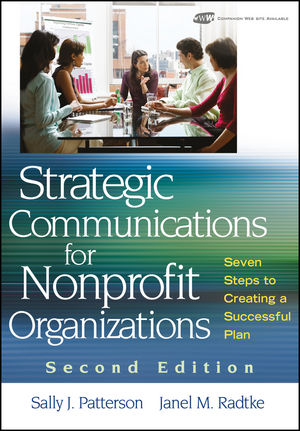Strategic Communications for Nonprofit Organizations: Seven Steps to Creating a Successful Plan, 2nd EditionISBN: 978-0-470-40122-4
Hardcover
288 pages
January 2009
 This is a Print-on-Demand title. It will be printed specifically to fill your order. Please allow an additional 10-15 days delivery time. The book is not returnable.
|
||||||
| Download Title | Size | Download |
|---|---|---|
Website OverviewWebsite WelcomeWelcome to the website for Strategic Communications Planning for Nonprofit Organizations. Here you will find the worksheets and documents to help you organize your planning sessions. The material is set up to address five strategic challenges addressed in the book:
Challenge 1If you aren?t certain where do begin or what your priorities should be for the planning process, complete Worksheet #1. Challenge 2A communications audit is a comprehensive analysis of an organization?s communications-internal and/or external-to review communications needs, policies, practices, and capacity in order to improve organization efficiency and effectiveness.
Challenge 3Nonprofit organizations, depending on their missions, generally deal with two types of crises: emergencies and controversies. Emergencies are predictable events that cause havoc for an organization or the people it serves and that may harm its ability to perform its mission. There are five major types of emergencies:
The responsibility for handling emergencies rests primarily with the staff, guided by disaster and risk management plans with board members providing collateral support where appropriate. Controversies are crises that threaten the organization?s reputation. Fraud accusations, legal disputes, or leadership conflicts are examples of controversies that challenge an organization?s integrity and effectiveness. Responding to a controversy usually requires board involvement and, possibly, board leadership. The crisis communications plan addresses six essential questions:
Crises do not usually get resolved with a single press statement or public announcement. It is important for crisis planners to realize that information needs, target audiences, and messaging will evolve over time, as more facts become known and as events unfold. The best way to deal with a crisis is before it happens. The strategic communications planning process provides an excellent opportunity for the board and staff to develop contingency plans for dealing with crises. A crisis communications planning team made up of both board and staff members should be created. Because crisis situations usually involve board engagement at a higher level that most communications work, both perspectives must be reflected in the planning process. The crisis communications planning team is responsible for assessing the possible crises that may confront the organization and for developing the framework for a plan of action in the event of a crisis. Crisis situations require articulate and well-timed communications with all stakeholders and the media. Crisis communications planning is a two-step process. The first step, performed by the crisis communications planning team, is to determine what challenges could affect the organization, what prevention strategies can be implemented, and what materials need to be compiled in advance of a possible crisis. The second step is to form the team that will lead the process when a crisis actually occurs, the crisis control team. Although ,members of the crisis communications planning team may be members of the crisis control team, decision makers at the top of the organization-the chief executive and the board chair-should provide the leadership when a crisis actually occurs. Challenge 4Everything you need (except the coffee, M&M?s, and other trinkets to motivate your team) is included in this section. Here you will find the worksheets, the template for the strategic communications plan and the Planet 3000 case study. Grab the following documents: strategic plan, financial plan, program and operational plans, technology plan, fundraising plan, organizational development plan and any other documents that should shape your thinking and you are ready to begin.
Challenge 5When the development team works with the Communications Action Team on strategies for approaching foundations, developing the background for proposals and grant applications and training staff to make face-to-face presentations to prospective donors, the case for sustainability is the platform to use.
|
31.00 KB | Click to Download |
| Building the Case for Sustainable Capacity | 33.00 KB | Click to Download |
| Conducting the Communications Audit | 32.50 KB | Click to Download |
| Strategic Communications Plan Template | 341.50 KB | Click to Download |
| Planet 3000 Strategic Plan Worksheets | 626.48 KB | Click to Download |
| Worksheet 1 | 25.50 KB | Click to Download |
| Worksheet 2 | 31.00 KB | Click to Download |
| Worksheet 3 | 31.00 KB | Click to Download |
| Worksheet 4 | 30.50 KB | Click to Download |
| Worksheet 5 | 25.50 KB | Click to Download |
| Worksheet 6 | 50.50 KB | Click to Download |
| Worksheet 7 | 35.00 KB | Click to Download |
| Worksheet 8 | 25.00 KB | Click to Download |
| Worksheet 9 | 28.00 KB | Click to Download |
| Worksheet 10 | 36.00 KB | Click to Download |
| Worksheet 11 | 75.00 KB | Click to Download |
| Worksheet 12 | 22.00 KB | Click to Download |
| Worksheet 13 | 38.50 KB | Click to Download |
| Worksheet 14 | 22.50 KB | Click to Download |
| Worksheet 15 | 22.50 KB | Click to Download |
| Worksheet 16 | 26.50 KB | Click to Download |
| Worksheet 17 | 25.50 KB | Click to Download |
| Worksheet 18 | 31.50 KB | Click to Download |
| Worksheet 19 | 28.50 KB | Click to Download |
| Worksheet 20 | 29.50 KB | Click to Download |
| Worksheet 21 | 47.00 KB | Click to Download |
| Worksheet 22 | 38.50 KB | Click to Download |
| Worksheet 23 | 28.00 KB | Click to Download |
| Worksheet 24 | 34.50 KB | Click to Download |



